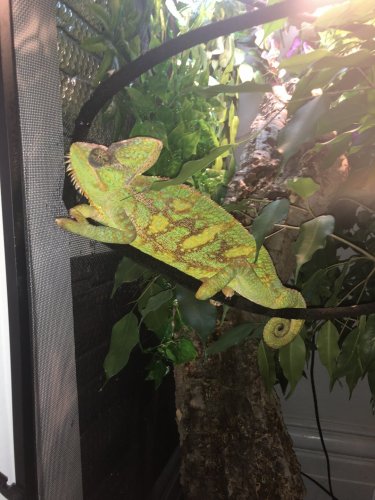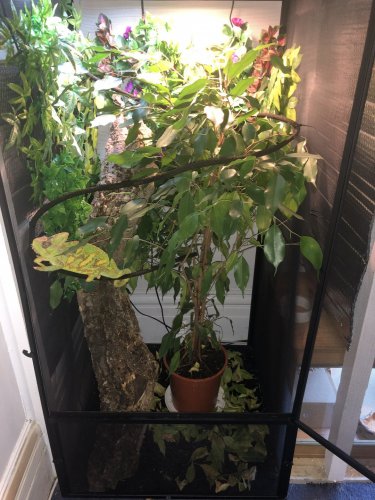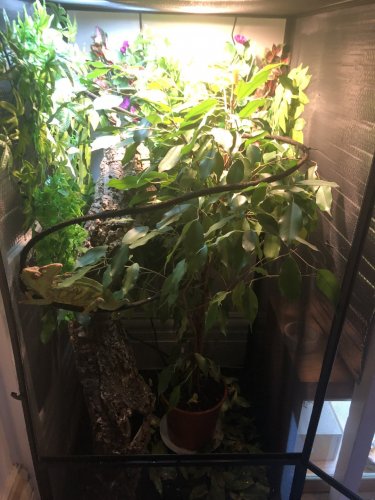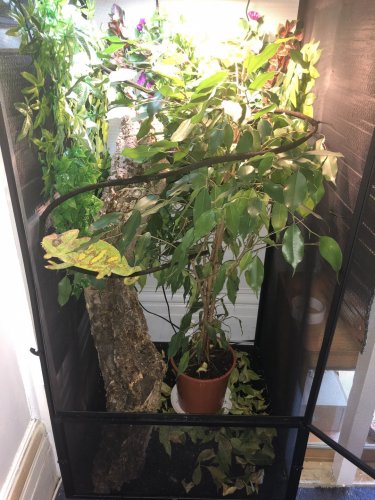jackcsmith91
Member
This isn’t so much a plea for help, more that I’d like people’s thoughts on something. I live in Brighton, England. It’s now winter. Yesterday morning we had a real feel temperature of -5c in the morning, and 2c in the afternoon. Today it’s 5 degrees. Tomorrow who knows. The temperatures are obviously pretty cold.
I live in a small room, in shared accommodation. Room temperature is about 17c.
I own Steve, a 2 year old Veiled.
Steve was in a 80cm wide, 40cm deep, 100cm terrarium. He was eating, pooping, urating fine.
He’s now in a 60cm wide, 60cm deep, 120cm tall terrarium with a lot of greenary. More so than in his old home.
I moved him into his new home on the 1st December. Since then he’s had ONE poop/urate.
Now, I’m not too sure if I should be worried or not? I have a beardie in the same room who is currently brumating, my thoughts are could the chams surrounding climate have the same affect?
He still seems himself, very alert and very much still has his teenage kind of ‘don’t come near me’ attitude.
But, he’s spending a lot of time in his cooler area, and not so much in his basking spot.
He has a 150w daylight exoterra basking spot lamp and a 10% UVB bulb. Both new, as of the day he moved into his new home.
Any thoughts on changes in behaviour during colder times?
I’m starting to look back at his past and going from 1 poop minimum a week to 1 in nearly two months and it’s only just dawned on me that a) somethings wrong or b) he just doesn’t like the cold like my beardie.
Any thoughts, tips, questions welcome.
Basking area 34c
Cool area 20c
Thanks
I live in a small room, in shared accommodation. Room temperature is about 17c.
I own Steve, a 2 year old Veiled.
Steve was in a 80cm wide, 40cm deep, 100cm terrarium. He was eating, pooping, urating fine.
He’s now in a 60cm wide, 60cm deep, 120cm tall terrarium with a lot of greenary. More so than in his old home.
I moved him into his new home on the 1st December. Since then he’s had ONE poop/urate.
Now, I’m not too sure if I should be worried or not? I have a beardie in the same room who is currently brumating, my thoughts are could the chams surrounding climate have the same affect?
He still seems himself, very alert and very much still has his teenage kind of ‘don’t come near me’ attitude.
But, he’s spending a lot of time in his cooler area, and not so much in his basking spot.
He has a 150w daylight exoterra basking spot lamp and a 10% UVB bulb. Both new, as of the day he moved into his new home.
Any thoughts on changes in behaviour during colder times?
I’m starting to look back at his past and going from 1 poop minimum a week to 1 in nearly two months and it’s only just dawned on me that a) somethings wrong or b) he just doesn’t like the cold like my beardie.
Any thoughts, tips, questions welcome.
Basking area 34c
Cool area 20c
Thanks









